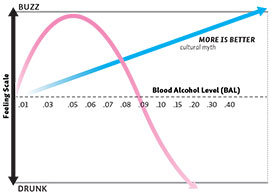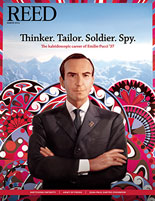
IRIS login | Reed College home Volume 93, No. 1: March 2014
Revel on the Level

Hoot, Hoot! Night Owls Christina Johnson ’15, Hannah Looney ’16, Nicole Ezell ’16, Stella Ziegler ’15, Emma Williams-Baron ’15, and G Luhman ’15. Photo by Matt D'Annunzio
The “Night Owls” are a different kind of party animal
By Chris Lydgate ’90
The lamp posts outside Old Dorm Block cast soft cones of light in the crisp November air as the three Night Owls stride through the Quad, their breath misting into the darkness. It’s a Friday night and the campus is crackling with energy. You sense it in the muffled throb of a distant bass line mingling with a sprinkle of laughter and the clack of heels echoing through the Sallyport. The Owls nod to each other.
It’s party time.
Armed with a flashlight, a walkie-talkie, a jug of water, and a backpack stuffed with snacks, sociology major Emma Williams-Baron ’15 leads the Owls towards Winch, where a rock band named Part of the Collective is playing a show in the Capehart room. Just as the Owls arrive, the band finishes up a set, and scores of hot, sweaty students stream out into the frosty evening, milling about the entrance to Winch.
“Night Owls!” Emma exclaims as she wanders through knots of revelers. “Anyone want a granola bar?”
The Owls are part of Reed’s Community Wellness Program, directed by Rachel Wagner, health and wellness manager in student services. Their mission is simple: to roam campus on weekend nights, engage their peers in friendly conversation, and offer smiles, snacks, and support. But the Owls are more than just a roving party patrol. They’ll walk you back to your dorm room if you’re ready to call it a night. They can summon help if you need medical attention. Along the way, they play a key role in educating their peers about the effects of drugs and alcohol, including common-sense tips on safe and responsible use. They are not only ambassadors of cheer—but also agents of change.

WORD TO THE WISE. Among other things, the Night Owls are working to familiarize Reed students with the biphasic curve. Many drinkers, especially teenagers, assume that the more they consume, the better they’ll feel. In fact, alcohol typically provokes a two-phase (biphasic) effect. At first, it produces a mild euphoria. But as the blood alcohol level mounts, it becomes a depressant, slowing nerve responses and interfering with cognition. Once you slide past the x-axis, there’s no chance of climbing back up the curve—better to call it a night.
Source: “How Alcohol Affects Us: The Biphasic Curve,” by David J. Hanson, SUNY.
An evening with the Night Owls offers a fascinating window into how the abstract philosophy of harm reduction actually works on the ground. At the Capehart party, the mood is festive and upbeat. Students hail the Owls with high-fives and queue up for gulps of cool water, which Night Owl (and environmental studies major) G Luhman ’15 dispenses from a heavy jug slung over his shoulder. In the student union, however, the scene is more laid-back. A clutch of students sits around the south loft playing the arcade game Big Buck Hunter. Absorbed by the game, the students don’t seem to know—or care—much about the Owls.
“We’re a student group,” Emma explains. “We’re here to keep an eye out for you. We don’t report anything illegal, but we do help you out if you’re having a hard time or need medical assistance.”
There’s a pause. Then G asks if anyone wants a granola bar. “Sure, I’ll take one,” a student shrugs. Soon the group is munching happily on the bars and talking about the band in Capehart. It’s a small but significant step—the Owls have made contact and established themselves as a friendly, nonthreatening resource that students can turn to if their Friday night takes a drastic turn for the worse.
![]()
The Night Owls are the spiritual descendants of the Karma Patrol, a student group which originated in the ’60s and which roams campus during Renn Fayre spreading good vibes and free bagels. When Gary Granger, community safety director, arrived at Reed in 2010, he was so impressed with the role Karma Patrol played in the spring/fall thesis parade that he sought to create a similar group that could operate throughout the academic year. After lengthy conversations with administrators, student leaders, and the Health & Counseling Center (HCC), the Owls were born—er, hatched. “I love the Night Owls and the role that they have come to play in the community,” Granger says.
Beyond support and snacks, the Night Owls also offer practical information. Before major campus occasions such as Renn Fayre, they hold interactive sessions (the last one was “Revel on Another Level”) where students can talk about alcohol myopia and the biphasic curve.
In the field, however, they scrupulously avoid moralizing. “They’re not there to judge,” says Wagner. “They’re not there to lecture. They’re there to help.”
To be sure, the Owls are only a single element of Reed’s overall strategy for responding to drug and alcohol use on campus. They are certainly no substitute for the trained professionals in the HCC , nor do they function as junior CSOs. But one of the factors driving drug and alcohol use on college campuses is the misperception that everyone’s getting wasted all the time—a myth the Owls dispel by their very presence.
Over the last three years, the Owls have earned a positive reputation. “The Night Owls are an invaluable resource for Reed,” says Mike Brody, dean of students. “Beyond the objective benefit, among the most meaningful contributions they make is to demonstrate an often ineffable level of care on the part of Reed students for other Reed students. The Night Owls help us do the critically important work of keeping Reed safe, and in so doing I believe they embody the Reed ideal of honor.”
The Owls fly through the Ping-Pong room and the pool room, which rocks to the tunes of the Detroit Cobras (until a hapless reporter accidentally disconnects the sound system). The Owls check common areas and bathrooms to make sure students are doing okay (but don’t intrude on dorm rooms unless they are invited in).
It’s hard to measure the Owls’ impact with any precision. On a typical night, they will verbally engage anywhere from 20 to 80 students and interact with a handful in more significant ways, such as helping them back to their dorm room. Sometimes a friendly conversation with an Owl will prompt tipsy students to cut their losses and call it a night. In other cases, understanding the biphasic curve can have a far-reaching effect on drinking habits.
Regardless of the statistics, it sure feels like the Owls are making a difference to the campus vibe. On the way to MacNaughton, students greet them with a hardy “Hoot! Hoot!” and an operatic trill. And, if truth be told, most of the dorms do not exactly resemble dens of vice. The kitchen in Foster II is warm and cozy with the smell of apple cobbler. In Chittick, the fireplace is crackling and a dozen dormies have gathered to watch the cult-classic horror flick The Thing—no drinking, no smoking, just popcorn and an old-fashioned movie night.
I leave the Owls at midnight. They’re walking through McKinley, talking excitedly about step aerobics and spider evolution, but I’m up past my bedtime and beginning to fade. To my delight, they ask if I want someone to walk me to my car.

LATEST COMMENTS
steve-jobs-1976 I knew Steve Jobs when he was on the second floor of Quincy. (Fall...
Utnapishtim - 2 weeks ago
Prof. Mason Drukman [political science 1964–70] This is gold, pure gold. God bless, Prof. Drukman.
puredog - 1 month ago
virginia-davis-1965 Such a good friend & compatriot in the day of Satyricon...
czarchasm - 4 months ago
John Peara Baba 1990 John died of a broken heart from losing his mom and then his...
kodachrome - 7 months ago
Carol Sawyer 1962 Who wrote this obit? I'm writing something about Carol Sawyer...
MsLaurie Pepper - 8 months ago
William W. Wissman MAT 1969 ...and THREE sisters. Sabra, the oldest, Mary, the middle, and...
riclf - 10 months ago